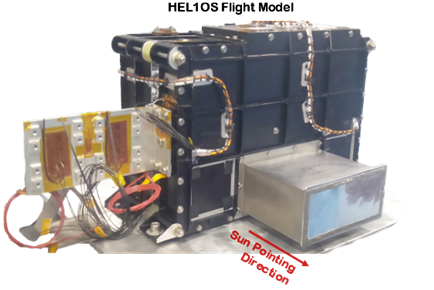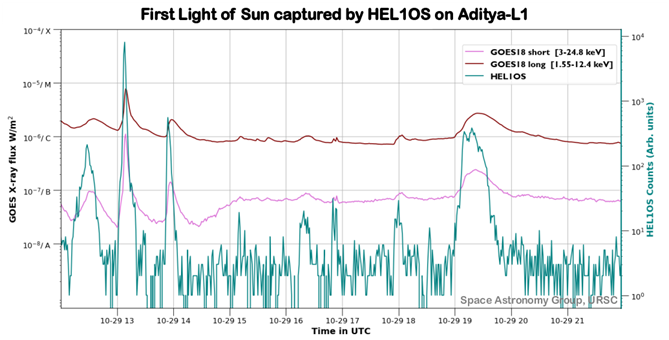HEL1OS on Aditya-L1 Solar Mission Observes Solar Flares in High Energy X-rays

The High Energy L1 Orbiting X-ray Spectrometer (HEL1OS) is making significant strides in solar observation as part of the Aditya-L1 Solar Mission by the Indian Space Research Organization (ISRO). HEL1OS operates in the wide X-ray energy band of 10 – 150 keV and plays a pivotal role in capturing the early impulsive phase of solar activity.
Solar flares, sudden brightenings of the solar atmosphere, release massive amounts of energy, ranging from 1027 to 1032 ergs, in a matter of minutes. These flares emit enhanced radiation across the electromagnetic spectrum, including radio waves, visible light, ultraviolet, soft X-rays, hard X-rays, and gamma rays. The initial impulsive phase of solar flares, particularly in hard X-rays, has been challenging to study due to its complex nature and rapid changes. The impulsive hard X-ray emission features multiple spectral components with high time variability, making it a formidable task to understand. HEL1OS aims to overcome these challenges with a set of detectors designed to cater to different energy ranges, providing high spectral and time resolution measurements.
HEL1OS has two types of detectors: Cadmium Telluride (CdTe), which operates in the 10 – 40 keV range, and Cadmium Zinc Telluride (CZT), which operates in the 20 – 150 keV range. The CZT detector, a state-of-the-art device near room temperature, covers the energy range of 20 keV to 150 keV. The CdTe detector, with better energy resolution at lower energies, is used for spectroscopic studies ranging from 10 keV to 40 keV. The collaboration of these detectors is essential to cover the overlap between thermal and non-thermal components of solar flares.
Developed by the Space Astronomy Group of the U. R. Rao Satellite Centre, ISRO, in Bengaluru and various entities of the center, HEL1OS was commissioned on October 27, 2023. Since its commissioning, HEL1OS has been continuously monitoring the Sun for hard X-ray activities.
The X-ray light curve detected by HEL1OS on October 29, 2023, during the period from approximately 12:00 to 22:00 UT, is a striking example of its capabilities. The curve reveals the impulsive phase of a solar flare, distinguished by its short duration and early peak time in comparison to observations made by GOES X-ray light curves. Additionally, the HEL1OS light curve indicates a few impulsive events that are less pronounced in the GOES light curve. Further analysis of HEL1OS data is expected to shed light on potential evidence of electron acceleration during these less prominent GOES events.





